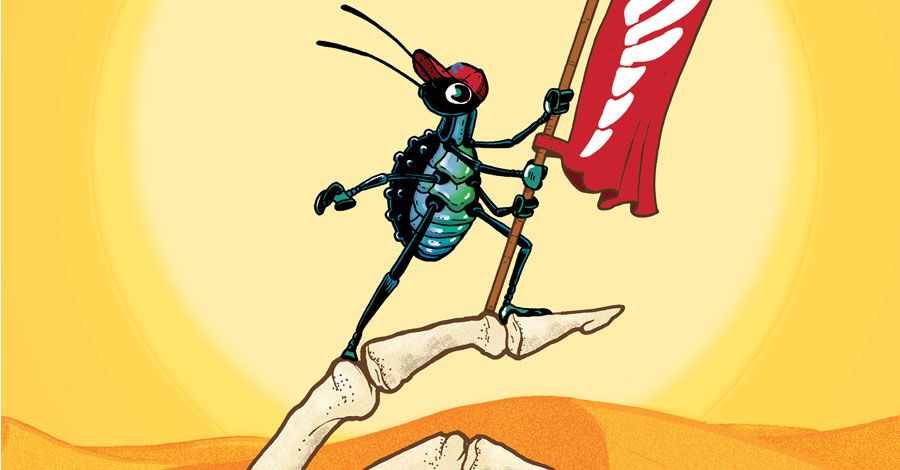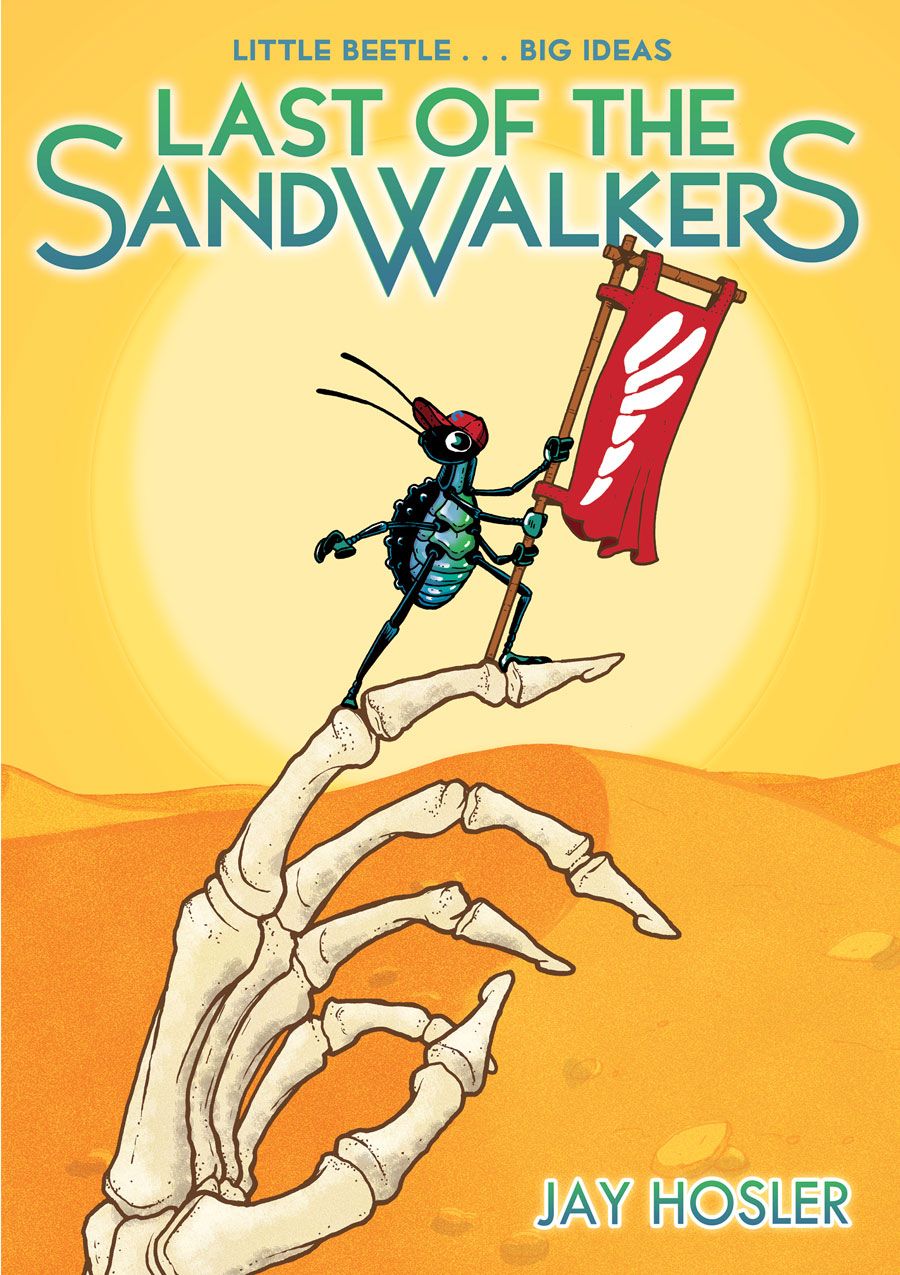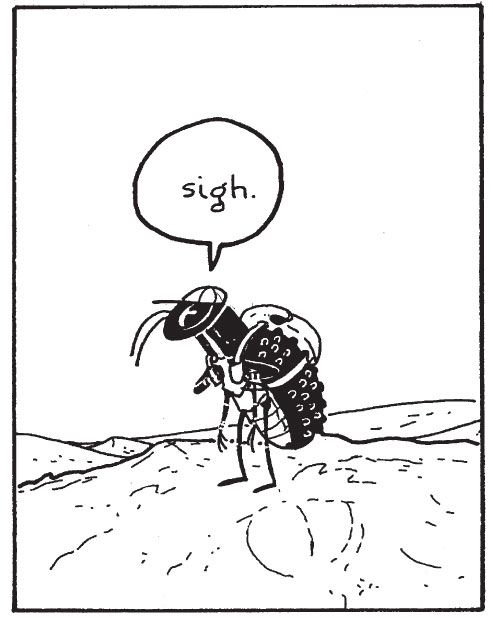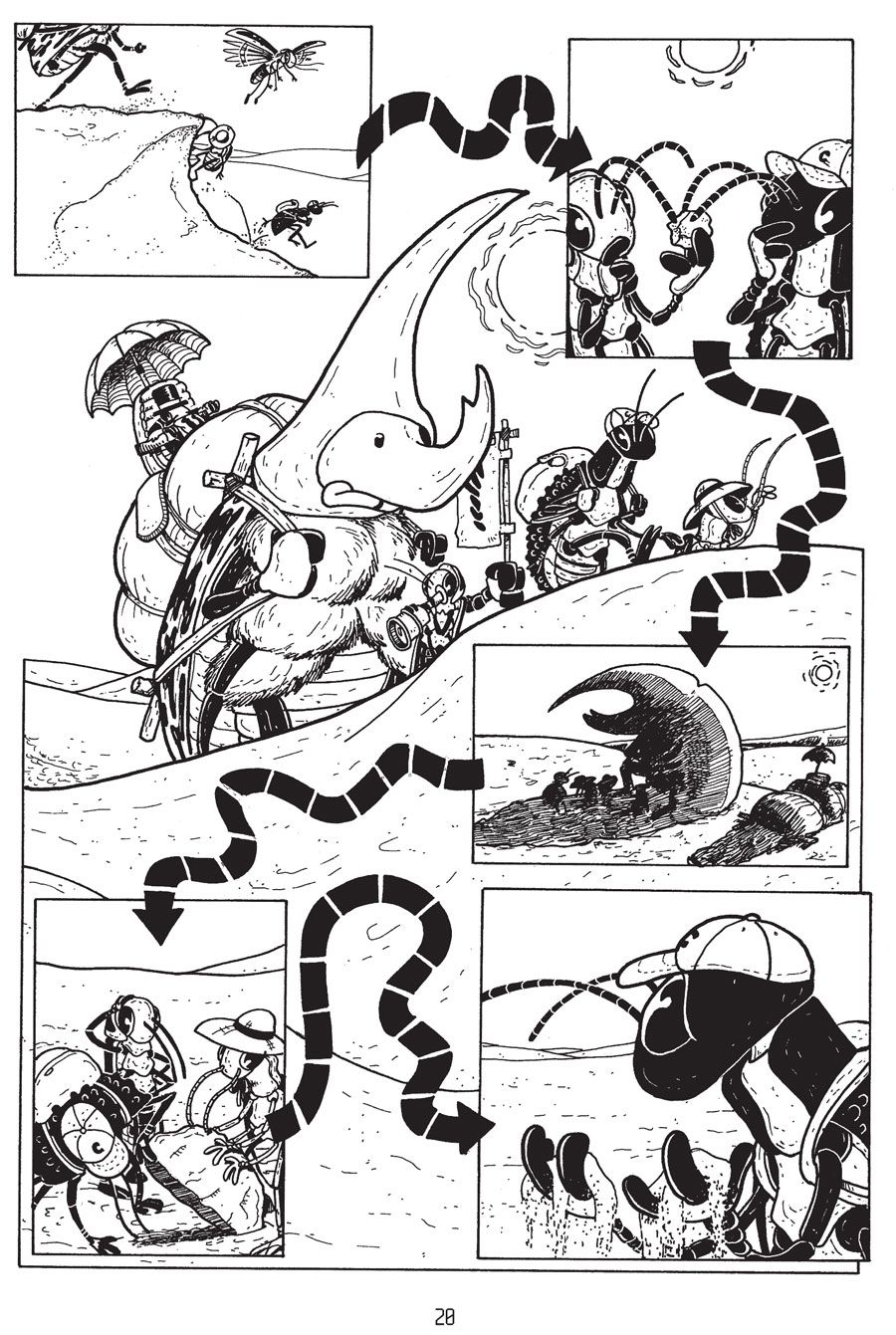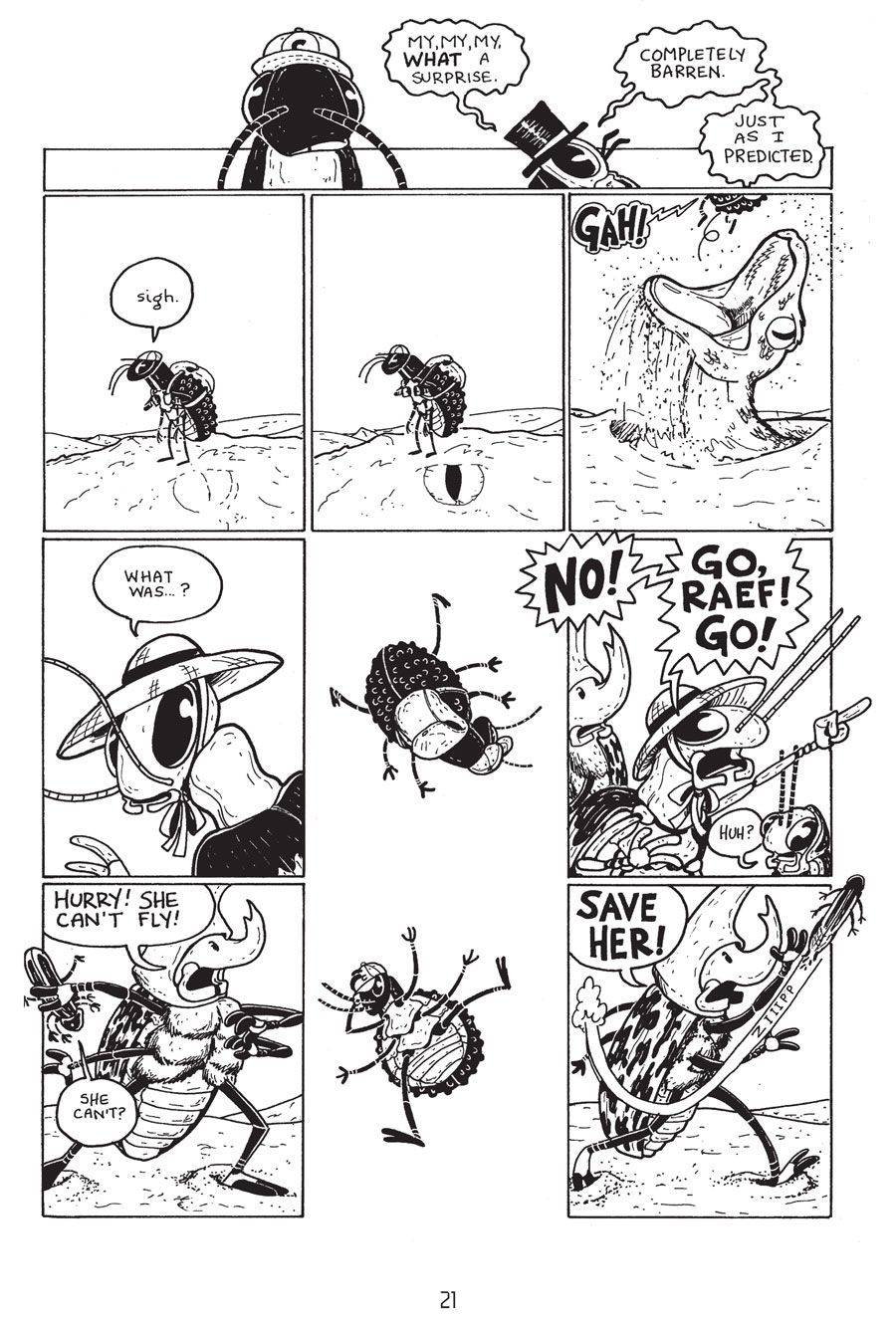If the life of a college professor seems like it would be filled with staid academia, you haven't met Juniata College's Associate Professor of Biology Jay Hosler. While you can read his work in scientific journals like "Behavioral Neuroscience" (114, No. 3) and "Journal of Insect Physiology" (45, No. 5), Hosley's been making a second career as a cartoonist of high adventure comics -- comics that just so happen to have a strong basis in very real science.
"Last of the Sandwalkers," Hosler's new book published by First Second, builds on the style he created for previous books like the well-regarded "Clan Apis," "The Sandwalk Adventures," and "Optical Allusions." In "Last of the Sandwalkers," Lucy leads a group of beetles on a scientific study expedition to discover if life exists beyond their sheltered oasis. However, anti-science elements seek to sabotage their venture, leaving Lucy and her team stranded far from home and on an epic quest to find their back to Coleopolis.
Along the way, they'll encounter dozens of insect species, each with its own special talents, some friendly, some less so. Lucy will have to prove her mettle as a leader and scientist, rallying the troops and find a way to overcome the longest of odds. Oh, and one of the Lucy's beetle cohorts is a cyborg!
Amidst all that adventuring, Hosler stuffed "Last of the Sandwalkers" with a ton of fascinating scientific details. CBR News spoke to the cartoonist about how "Sandwalkers" is a clear homage to a very specific classic superhero team and takes the approach of another well-regarded adventure comic to embed real knowledge in an action-based plot.
CBR News: Jay, while you inject a lot of real science into the beetles' journey, the beetles themselves (and several other insects they encounter) are given very human motivations. When approaching a book like this, is there any concern with balancing relatable protagonists against a glimmer of the scientific truth of beetles' social roles and life cycles (as much as possible when one of the beetles is a cyborg!)?
Jay Hosler: I think it was my friend Robin Brenner who first told me about the Mirror and the Window. Robin is a librarian and she pointed that the best fiction does two things. It has characters and situations that reflect something relevant about a reader's life (the mirror) but also gives readers a glimpse into a world that is unknown to them (the window). That's a nice articulation of what I have always tried to do.
Effectively balancing the science and story is critical. My interests are sharing something about the natural wonders that many of us overlook, take for granted or just never imagined existed. When I do write about the science in a book, it's important to get it as right as I possibly can. It's even better if understanding the science becomes critical to advancing the plot. But I don't want to overburden the story with copious detail. There can be preconceived barriers to reading about science, so my primary goal is to inspire interest and wonder. If that makes someone want to learn more about a topic then that is a win. If all it does is increase someone's appreciation of the amazing stuff around us everyday then that's good, too.
That said, if there aren't characters and stories to care about most readers won't stick around for the science. Research is starting to tell us what we have known intuitively for years. Humans are wired for stories and pictures. We empathize with the plight of a character and internalize the events of a story. Most of my books have been pretty personal. "Clans Apis" was about my own fear of death; "The Sandwalk Adventures" is about coming to terms with the theory of natural selection in a very theistic society; and "Last of the Sandwalkers" is about the joy of scientific exploration and the opposition scientists encounter from those that feel threatened by new, challenging ideas.
In the end, I really just want to tell a good story that readers of all ages can enjoy and want to read more than once. It just so happens that the topics I enjoy exploring are the creepy crawlies skittering underfoot.
Lucy's quest and all the adventures that follow give the beetles' journey an Indiana Jones-esque quality, but with more scientific grounding. You've really cast scientific exploration as an adventure. Is it important to help children understand the potential excitement of science and discovery?
Kids are born scientists. From the moment they can speak, they ask uncomfortable, simple questions for which we have only the dimmest understanding. They are enthusiastic explorers and creators in elementary school, but as they start to transition to middle school something starts to happen. Enthusiasm becomes unacceptable socially (except for the most banal of things) and hormonal secretions make kids timid. My books target kids in that range specifically because I want to keep the science flame alive in as many of those kids as I can reach. I want them to have a place to experience the exuberance of discovery and immerse themselves in real world of wonders. The natural history of our world is one of the greatest epics ever to unfold. If I can tell a portion of that story well, it might inspire a mind to explore the world for themselves.
Hosler on the Educational "Optical Allusions"
While the structure of "Last of the Sandwalkers" has the quality of an epic quest, as the beetles strive to return home, there's also a superhero vibe to it, isn't there?. Every encounter with a new creature exposes Lucy and her team to some fantastical new ability.
My first comic was "Marvel Team-Up #19" in which Spider-Man and Ka-Zar team up to fight Stegron the Dinosaur Man in the dinosaur-laden Savage Land. Homina homina. My love of dinosaurs drew me to the comic but the super-hero/science nerd captured my interest. As a kid, Spider-Man and the Fantastic Four appealed to me so much because their adventures were often rooted in or dependent upon some sort of super science. I had no delusions about accuracy, but the idea that the writers were attempting to connect events and abilities to natural explanations was pretty stimulating for my middle school brain.
At some level, "Last of the Sandwalkers" is my homage to the Fantastic Four: a family with unique abilities, exploring the unknown and overcoming massive obstacles through teamwork. On another level, their story reflects the real life heroics of any explorer who sails off into the unknown.
I don't think it's a stretch to say that certain anti-science sentiments are prevalent in the world today (and, really, throughout most of human history), and your beetles face those obstacles as well. Confronting superstition and anti-science bias too often seems like the biggest obstacle to scientific discovery, doesn't it?
Science is a process that, when done well, involves rigorous review and debate about most findings. Any given hypothesis or theory is put through the ringer by a bunch of strong-minded, independent thinkers before it is even marginally accepted. Are mistakes made? Sure. Science is a human endeavor and humans screw up, but for the most part the process is self-correcting and eventually we move closer to a more accurate picture of the natural world.
Now imagine a bunch of experts dedicating their lives to a problem, experimenting, collecting data, etc. They debate the strengths and weaknesses of an idea, try to prove each other right or wrong, and after decades and decades of the slow accretion of verifiable, reproducible results they reach a consensus about a given topic: disease is caused by germs, life on earth has evolved, the earth is warming because of human activity. Now imagine that these consensus statements are met with the following responses: "Nuh uh, disease is caused by sin," "Nuh uh, life was created supernaturally," and "Nuh, uh, we would never do that!"
The opposition to these scientific ideas is not founded in evidence, but is grounded in economic and religious motivations. It would be one thing if these voices were on the fringe of society, but they're not. In the US, anti-science groups wield significant economic and social pressure and can obfuscate the truth or warp our textbooks to suit their agendas. It is our role as citizens to be informed about science and make decisions based on the best evidence. I hope my comics can play a small role in helping readers understand science better.
I can't believe you left us hanging on the story of how Raef becomes a robot!
I know, I know, but you know the old saying: for every question science comics answer, two more pop up. Guess I just have to write another beetle story...
When you're plotting a book like this, an adventure plot with science-based details along the way, do you worry about the balance between giving readers a good time versus providing educational content? Or is it a case of if you do your job correctly, the science is as exciting as the quest to reach home?
I work for the latter. The truth is that I try not to think of my comics as educational, per se. Stan Sakai's "Usagi Yojimbo" has been my guiding light in this regard. Because of reading "Usagi Yojimbo," I have a sense of how metal is folded to make a samurai sword, insight into how kelp is farmed and a basic idea of Japanese mythology. Sakai has woven historical aspects into his stories, but I doubt anyone would argue "Usagi" is an educational comic. My goal is to write natural historical fiction with compelling characters and plots that depend on an understanding of the science at hand. If I can do that to the satisfaction of my wife and sons then I am pretty confident in the work.
Of all the science fields available to you, what's the appeal of entomology? While some of your other books have gone into other fields, "Last of the Sandwalkers" and "Clan Apis" (and to some degree, "The Sandwalk Adventures") both focused on animals that most of us consider a nuisance, or worse.
Insects are appealing to me because of their utter alien nature. In so many ways they are our biological inverse. They have an external skeleton and are cold-blooded. They are small, six-legged, compartmentalized critters that can fly. And that's just the baseline. Throw in the multitude of evolutionary adaptations they have for survival and insects represent an astonishing pantheon of super-powered aliens to which most of us are oblivious. The very idea makes my inner-middle schooler vibrate with delight. In terms of number of species, they are the most successful group of multicellular animals on the planet. Their success and their adaptations have always been a source of fascination for me and as an adult I am taking the opportunity to write the comics about insects that I wish had existed when I was a kid.
You've published several articles in scientific journals as well, but science-based comics seem to be your real focus. Obviously very different venues with very different rewards, but do the two approaches and audiences share any overlap?
At one level, the approaches are very different in terms of obvious things like language and style, but fundamentally they are about effectively communicating science. The truth is,I find writing science comics more challenging because I can't fall back on jargon shorthand and I have to write for an audience that might have no prior knowledge of the subject. As I tell my students, you only understand something well when you can explain it in simple terms.
As far as audiences are concerned, I hear from scientists who share my comics as a way to reach out to non-scientists. All scientists have their individual skills. Some are great communicators, others ingenious experimentalists, still other dizzying theoreticians. Some are two of the three and a very few have it all. My strongest skill set is in communicating ideas with comics. It's a nice little niche that isn't occupied by many others so I don't suffer too dramatically by comparison with my peers. I have been fortunate that fellow scientists have been so supportive of my work.
What's next for you?
Still working on that. Something about science, I think. Possibly involving insects. Doesn't that sound exciting?
"Last of the Sandwalkers" is available now from First Second Books.

